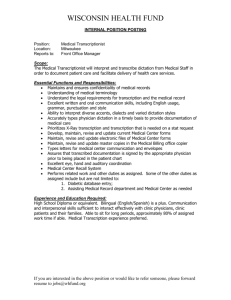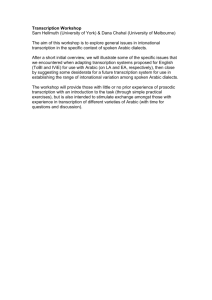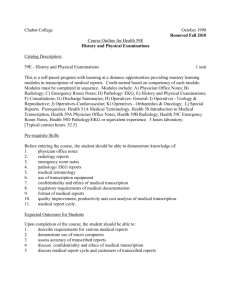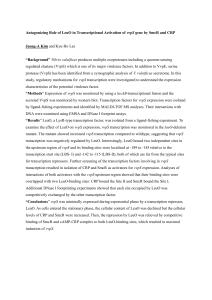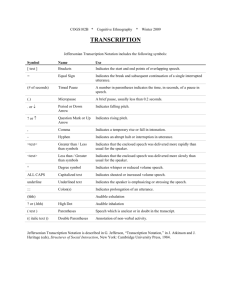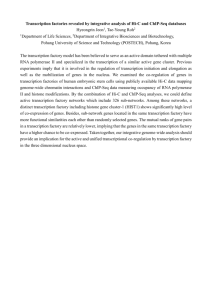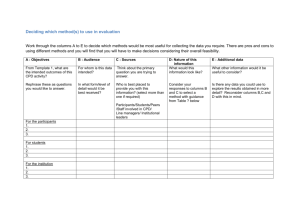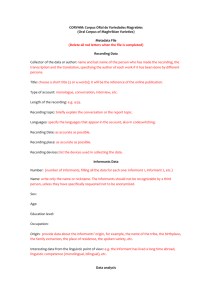HIT201_Feb2011 - Heartland Community College
advertisement
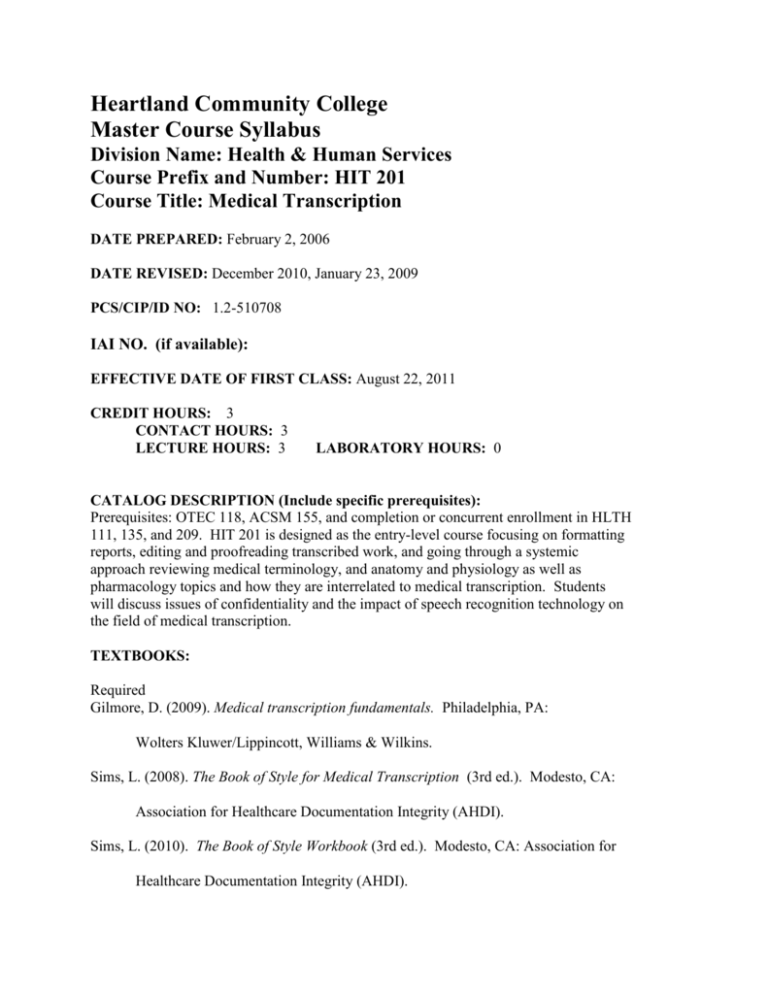
Heartland Community College Master Course Syllabus Division Name: Health & Human Services Course Prefix and Number: HIT 201 Course Title: Medical Transcription DATE PREPARED: February 2, 2006 DATE REVISED: December 2010, January 23, 2009 PCS/CIP/ID NO: 1.2-510708 IAI NO. (if available): EFFECTIVE DATE OF FIRST CLASS: August 22, 2011 CREDIT HOURS: 3 CONTACT HOURS: 3 LECTURE HOURS: 3 LABORATORY HOURS: 0 CATALOG DESCRIPTION (Include specific prerequisites): Prerequisites: OTEC 118, ACSM 155, and completion or concurrent enrollment in HLTH 111, 135, and 209. HIT 201 is designed as the entry-level course focusing on formatting reports, editing and proofreading transcribed work, and going through a systemic approach reviewing medical terminology, and anatomy and physiology as well as pharmacology topics and how they are interrelated to medical transcription. Students will discuss issues of confidentiality and the impact of speech recognition technology on the field of medical transcription. TEXTBOOKS: Required Gilmore, D. (2009). Medical transcription fundamentals. Philadelphia, PA: Wolters Kluwer/Lippincott, Williams & Wilkins. Sims, L. (2008). The Book of Style for Medical Transcription (3rd ed.). Modesto, CA: Association for Healthcare Documentation Integrity (AHDI). Sims, L. (2010). The Book of Style Workbook (3rd ed.). Modesto, CA: Association for Healthcare Documentation Integrity (AHDI). Clayton, L.T. Ed. (2005). Taber’s Cyclopedic Medical Dictionary (21st ed.). Philadelphia, PA: F.A. Davis and Co. Optional Tessier, C. (2004). The Surgical Word Book (3rd ed.). St. Louis, MO: Elsevier Saunders Publications. RELATIONSHIP TO ACADEMIC DEVELOPMENT PROGRAMS AND TRANSFERABILITY: HIT 201 was designed to meet the specific needs of an Associate of Applied Science degree and not necessarily as a transfer course, particularly in relation to the Illinois Articulation Initiative. This course may transfer to various institutions in a variety of ways. Please see an academic advisor for an explanation concerning transfer options. COURSE OBJECTIVES (Learning Outcomes) Upon completion of the course, the student will be able to: Course Outcomes Gen. Ed. Range of Outcomes Assessment Methods Practice knowledge of medical In-class & homework terminology, anatomy and physiology, CO3 transcription exercises diseases, signs and symptoms, Examinations pharmacology, and lab values to produce accurate health records. In-class & homework transcription exercises Operate word processing, dictation, and other transcription equipment to produce accurate health record copy. In-class & homework transcription exercises Examinations Produce health record documents that demonstrate skill in English, grammar, punctuation, style, and editing. Practice good listening techniques in order to produce accurate health record copy. Identify reference manuals and resources to produce accurate health record copy based on examples and scenarios. COURSE/LAB OUTLINE: I. Listening Skills PS1 In-class & homework transcription exercises Examinations In-class & homework transcription exercises II. A. Vocabulary Density B. Variations in Dictation Body Systems III. Medical Specialties IV. Styles & Formatting V. Legal Implications A. Confidentiality B. HIPAA Implications C. Association of Healthcare Documentation Integrity (AHDI) Standards METHOD OF EVALUATION (Tests/Exams, Grading System): Transcription Exercises Homework Assignments Midterm Exam Final Exam Grading Scale: A B C D F 40% 20% 20% 20% 90-100% 80-89% 70-79% 60-69% 59% and below REQUIRED WRITING AND READING: Required reading includes textbook and additional reading in class averaging 50 pages per week. Students will be required to transcribe in-class and homework assignments accurately conforming to style and formatting with proper grammar and punctuation.

